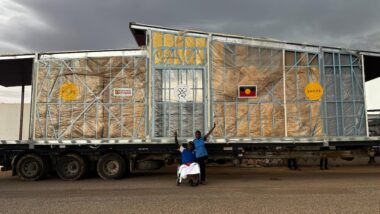A new report shows internet access in Australia’s remote and very remote communities improved in the past two years as 4G/5G, Wi-Fi and satellite infrastructure is bolstered across regional Australia.
The Mapping the Digital Gap report led by RMIT University found a 12% increase in internet access and a 19% increase in regular internet usage from 2022 to 2024.
Despite improvements in access, however, the survey found cost remains a barrier to greater digital inclusion.
Affordability is limiting uptake
More than two-thirds of First Nations people surveyed in Australia’s remote and very remote communities are struggling to afford internet access, while over half the communities and homelands still don't have mobile access.
Close to 70% of survey respondents reported they had made sacrifices or cut back on essential costs to afford internet access, up from 40% in 2022.
The study found 99% of mobile phone users rely on prepaid credit recharges, with low and unreliable incomes limiting uptake of better value monthly plans.
Out of Australia’s 1,505 remote and very remote communities, about 796 don’t have access to mobile services.
RMIT University researchers have been mapping digital inclusion in remote First Nations communities over three years.
Lead investigator Dr Daniel Featherstone said the gap is showing signs of narrowing but some striking inequalities remain.
“As access to mobile technology slowly improves, we’re finding affordability is still a critical barrier to digital inclusion,” he said.
Featherstone and his RMIT research team visited 12 remote First Nations communities, working with local First Nations organisations.
The purpose is to track progress towards Aboriginal and Torres Strait Islander people having equal levels of digital inclusion by 2026, Target 17 of the National Partnership Agreement on Closing the Gap.
Digital inclusion initiatives are improving access
There have been significant developments aimed at improving digital inclusion between 2022 and 2024, particularly in terms of Wi-Fi and mobile infrastructure to enable access.
Featherstone said there’s been a 6% increase in regular internet users in remote First Nations communities since 2022.
“More than 60% of people we surveyed are now using the internet several times a day or more,” he said.
“It’s an improvement but there's still 14% of non-internet users and many sites still struggle with patchy, slow and unreliable services.”
Work to improve this is ongoing, with expanded delivery of free Wi-Fi hotspots and mesh networks playing an important role in improving access.
There was a 31% increase in those accessing the internet via Wi-Fi in public spaces, up from 15% in 2022.
Telstra, the study’s industry partner, has been installing 4G mobile towers in remote communities, providing essential connectivity.
Starlink introduced new satellites covering Northern Australia in 2022, which has seen rapid uptake among community agencies and staff.
But as one community leader commented, digital inclusion is not just about access to technology for the sake of it.
“It's about empowering our communities to participate fully in the digital world. This project has been instrumental in highlighting the unique challenges we face and the progress we are making towards closing the digital gap," they said.
Researchers noted more of Australia’s First Nations people are engaging online with music, videos and games, up 17% since 2022, as well as high social media use to connect with family and friends.
“This highlights that First Nations people are engaging in online activities that are relevant to their lives and communities, despite significant barriers around access and affordability,” Featherstone said.
There was also increased use of online banking, government services and online shopping, however some communities had reductions in internet usage.
It could be because there’s been a 19% drop in households who own computers, meaning there’s less opportunity, particularly for children, to learn how to use computers at home.
Lack of identification and two-factor authentication plus regular changes in mobile number and low use of email, impacted online engagement.
So too did a lack of digital support, poor accessibility, English literacy and concerns about scams and cyber-safety issues.
Still more to do on closing the digital gap
Featherstone said there remains an urgent need for programs and support to address digital ability.
“The planned Digital Mentors program included in 2024 Budget measures will be a positive development,” he said.
“But with so many communities, more expansive programs for digital skills, support and online safety awareness are needed.
“Without this, the gap in digital ability is likely to further widen, particularly in a period of rapid digital transformation to online service delivery and withdrawal of face to face services.”
The Mapping the Digital Gap project is funded by Telstra and the Australian Research Council Centre of Excellence for Automated Decision-Making and Society.
The project’s second phase starts next year, with funding for a larger-scale survey measuring access to mobile technology for First Nations people across Australia, not just in remote communities.
Mapping the Digital Gap: 2024 Outcomes Report was prepared for ARC Centre of Excellence for Automated Decision-Making and Society. (DOI: http://doi.org/10.60836/xspj-w062).
Co-authors: Daniel Featherstone, Lyndon Ormond-Parker, Julian Thomas, Sharon Parkinson, Kieran Hegarty, Leah Hawkins, Jenny Kennedy, Lucy Valenta and Lauren Ganley.
Contact details:
Interviews and media enquiries: RMIT External Affairs and Media, +61 499 515 417 or [email protected]

